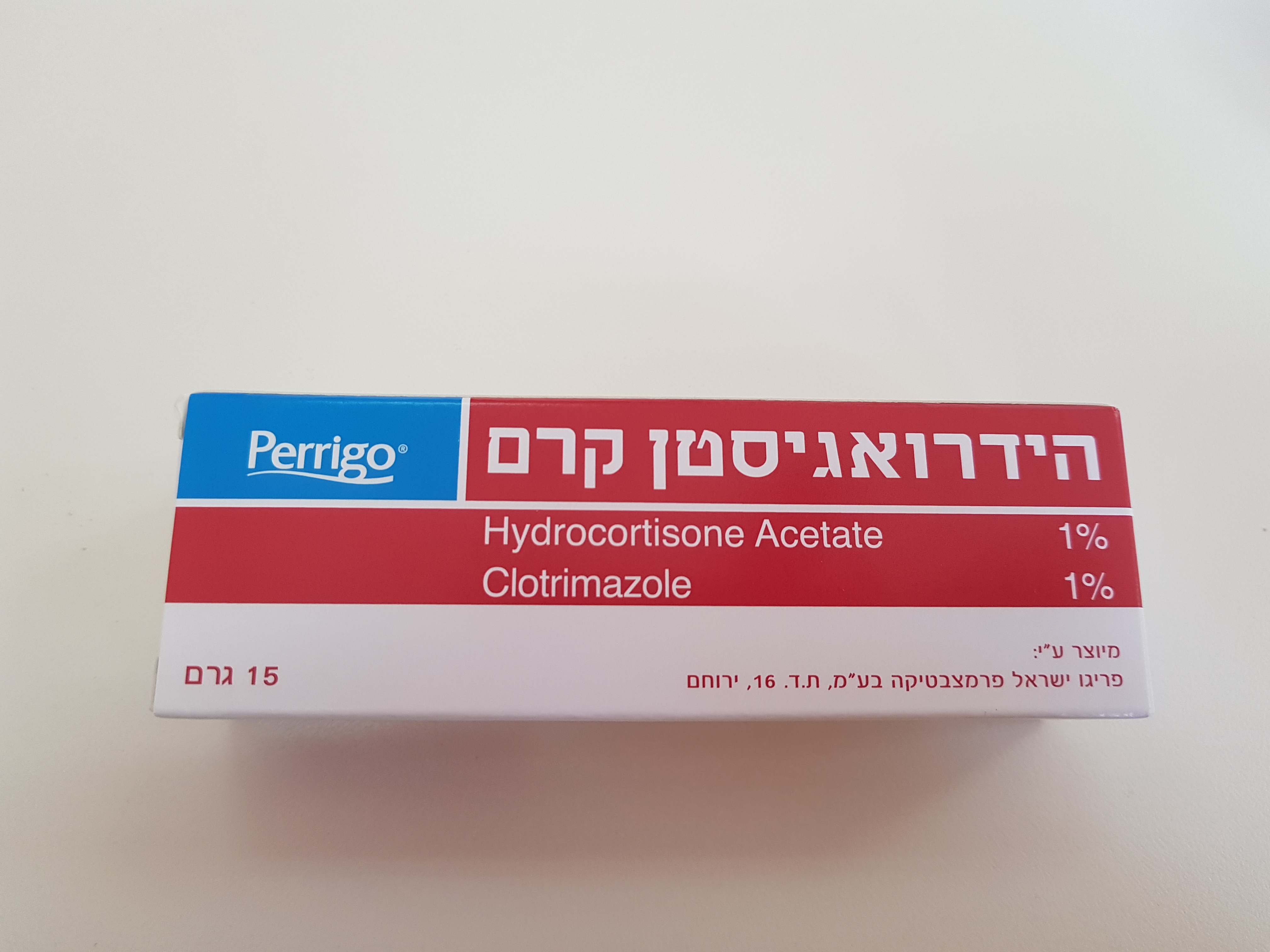Quest for the right Drug

הידרואגיסטן קרם HYDROAGISTEN CREAM (CLOTRIMAZOLE, HYDROCORTISONE ACETATE)
תרופה במרשם
תרופה בסל
נרקוטיקה
ציטוטוקסיקה
צורת מתן:
עורי : DERMAL
צורת מינון:
קרם : CREAM
עלון לרופא
מינוניםPosology התוויות
Indications תופעות לוואי
Adverse reactions התוויות נגד
Contraindications אינטראקציות
Interactions מינון יתר
Overdose הריון/הנקה
Pregnancy & Lactation אוכלוסיות מיוחדות
Special populations תכונות פרמקולוגיות
Pharmacological properties מידע רוקחי
Pharmaceutical particulars אזהרת שימוש
Special Warning עלון לרופא
Physicians Leaflet
Pharmacological properties : תכונות פרמקולוגיות
Pharmacodynamic Properties
5.1. Pharmacodynamic properties Pharmacotherapeutic group: Antifungals for topical use – imidazole and triazole derivatives, combinations. ATC Code: D01AC20 Hydroagisten cream is a combination of clotrimazole and hydrocortisone acetate. Mechanism of Action Clotrimazole: Clotrimazole acts against fungi by inhibiting ergosterol synthesis. Inhibition of ergosterol synthesis leads to structural and functional impairment of the fungal cytoplasmic membrane. Clotrimazole has a broad antimycotic spectrum of action in vitro and in vivo, which includes dermatophytes, yeasts, moulds, etc. Under appropriate test conditions, the MIC values for these types of fungi are in the region of less than 0.062-8.0 µg/ml substrate. The mode of action of clotrimazole is fungistatic or fungicidal depending on the concentration of clotrimazole at the site of infection. In vitro activity is limited to proliferating fungal elements; fungal spores are only slightly sensitive. In addition to its antimycotic action, clotrimazole also acts on gram-positive microorganisms (Streptococci / Staphylococci / Gardnerella vaginalis), and gram- negative microorganisms (Bacteroides). In vitro clotrimazole inhibits the multiplication of Corynebacteria and gram-positive cocci - with the exception of Enterococci – in concentrations of 0.5-10 µg/ml substrate. Primary resistant variants of sensitive fungal species are very rare; the development of secondary resistance by sensitive fungi has so far only been observed in very isolated cases under therapeutic conditions. Hydrocortisone: Hydrocortisone is a weak corticosteroid with both glucocorticoid and to a lesser extent mineralocorticoid activity. As the active ingredient in a topical cream it exerts anti- phlogistic, antipruriginous, antiexudative and antiallergic effects. Hydrocortisone, like other topically applied glucocorticoids, exerts an anti- inflammatory, antiallergenic, immunosuppressive, antimitotic (antiproliferative), antipruriginous and vasoconstrictive effect on skin. Thus, in addition to the elimination of inflammation and pruritis, a normalisation of keratinisation, inhibition of excess fibroblast activity and epidermopoiesis, degradation of pathological metabolic products and inhibition of acantholysis are achieved. However, this is not a curative therapy but rather a symptomatic treatment.
Pharmacokinetic Properties
5.2. Pharmacokinetic properties Clotrimazole: Pharmacokinetic investigations after dermal application have shown that clotrimazole is minimally absorbed from intact or inflamed skin into the human blood circulation. The resulting peak serum concentrations of clotrimazole were below the detection limit of 0.001 µg/ml, suggesting that clotrimazole applied topically in unlikely to lead to measurable systemic effects or side effects. Hydrocortisone : Dermal absorption of hydrocortisone depends on the thickness and condition of the skin. In healthy skin no systemic effects of corticoids have been observed after local application. However, in the case of inflamed or damaged skin, cutaneous absorption may be increased depending on the site of application, use of occlusive dressings, the degree of skin damage, and size of the treated area. Systemic effects can not be ruled out under such conditions. An increase in the skin temperature or moisture content, e.g. in skin folds or under an occlusive dressing, also promotes absorption. In infants and small children the epidermal "barrier" is still poorly developed, which facilitates transcutaneous uptake of drugs. The occurrence of systemic effects depends partly on the dose and, to a much greater extent, on the duration of treatment. More than 90% of the hydrocortisone acetate absorbed is bound to plasma proteins. Hydrocortisone acetate is metabolised in the liver and tissues, and the metabolites are excreted with urine. The biological half-life is approximately 100 minutes. No relevant absorption of hydrocortisone is expected after its use for a short period on limited skin inflamed areas.

שימוש לפי פנקס קופ''ח כללית 1994
Mycotic infections of the skin associated with inflammation
תאריך הכללה מקורי בסל
01/01/1995
הגבלות
תרופה שאושרה לשימוש כללי בקופ'ח
רישום
042 82 24888 00
מחיר
0 ₪
מידע נוסף
עלון מידע לצרכן
22.04.18 - עלון לצרכן 02.11.20 - עלון לצרכן אנגלית 19.07.21 - עלון לצרכן אנגלית 19.07.21 - עלון לצרכן עברית 02.11.20 - עלון לצרכן ערבית 19.07.21 - עלון לצרכן ערבית 06.06.23 - עלון לצרכן אנגלית 06.06.23 - עלון לצרכן עברית 06.06.23 - עלון לצרכן ערבית 04.06.24 - עלון לצרכן עברית 14.10.24 - עלון לצרכן אנגלית 11.08.14 - החמרה לעלון 02.11.20 - החמרה לעלוןלתרופה במאגר משרד הבריאות
הידרואגיסטן קרם